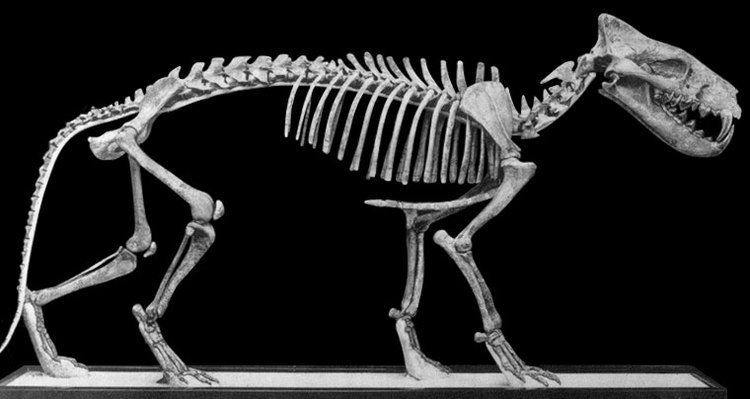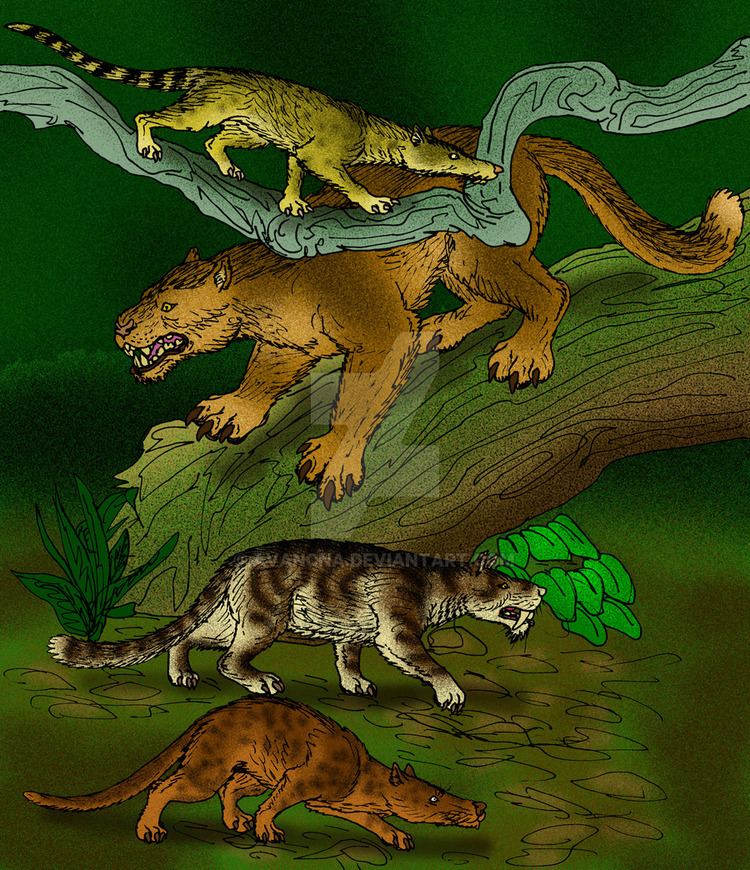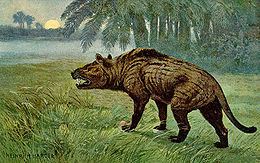Scientific name Creodonta Higher classification Placentals | ||
 | ||
Similar Mammal, Hyaenodon, Hyaenodontidae, Condylarth, Mesonychid | ||
Creodonta top 9 facts
Creodonta is an extinct, potentially polyphyletic order of carnivorous mammals that lived from the Paleocene to the Miocene epochs. Because they both possess carnassial teeth, creodonts and carnivorans were once thought to have shared a common ancestor, but given that different teeth are involved in making up the carnassials (both between creodonts and carnivorans and between the main groups of creodonts), this appears to be a case of evolutionary convergence. Carnassials are also known in other mammal clades, such as in the extinct bat Necromantis.
Contents
- Creodonta top 9 facts
- Systematics
- Dentition
- Cranium
- Postcranial skeleton
- Size
- Diet and feeding
- Evolution
- Habitat
- Extinction
- References
Two distinct families were historically thought to compose the order: Oxyaenidae and Hyaenodontidae. They may both represent separate orders of fossil mammals related to carnivoramorphs or are descended from more basal taxa.

Creodonts had an extensive range, both geographically and temporally. They are known from the late Paleocene through the late Oligocene in North America, the early Eocene through late Oligocene in Europe, from the early Eocene through late Miocene in Asia, and from the Paleocene to the late Miocene in Africa.

Creodonts were the first large, obviously carnivorous mammals with the radiation of the oxyaenids in the late Paleocene. During the Paleogene, they were the most abundant form of terrestrial carnivore in the Old World. In Oligocene Africa, they were the dominant predatory group. They competed with the Mesonychids and the Entelodonts and ultimately outlasted them by the start of the Oligocene and by the middle of the Miocene respectively, but lost ground to the carnivorans. The last genus became extinct 11.1 million years ago, and carnivorans now occupy their ecological niches.

Systematics

"Creodonta" was coined by Edward Drinker Cope in 1875. Cope included the oxyaenids and the viverravid Didymictis but omitted the hyaenodontids. In 1880. he expanded the term to include Miacidae, Arctocyonidae, Leptictidae (now Pseudorhyncocyonidae), Oxyaenidae, Ambloctonidae and Mesonychidae. Cope originally placed creodonts within the Insectivora. In 1884, however, he regarded them as a basal group from which both carnivorans and insectivorans arose. Hyaenodontidae was not included among the creodonts until 1909. Over time, various groups were removed, and by 1969 it contained, as it does today, only the oxyaenids and the hyaenodontids.
One view of the position of the group is that Creodonta and Carnivora are sister taxa (within a superorder Ferae). Others have argued that insectivorans are more closely related to carnivorans, and creodonts, therefore, are basal eutherians. Others have suggested that Creodonta might not be monophyletic. Polly has argued that the only available synapomorphy between oxyaenids and hyaenodontids is a large metastylar blade on the first molar (M1), but he believes that that feature is common for all basal eutheria. Separating Oxyaenidae from Hyaenodontidae would also comport with biogeographic evidence, since the first oxyaenid is known from the North American early Paleocene and the first hyaenodontids are from very late Paleocene of North Africa.
Complicating this arrangement is the tentative endorsement by Gunnell of the erection of a third family, Limnocyonidae. The group includes taxa that were once considered oxyaenids, such as Limnocyon, Thinocyon and Prolimnocyon Wortman had even erected a subfamily of Limnocyoninae within the oxyaenids. Van Valen nests the same subfamily (including Oxyaenodon) within Hyaenodontidae. Gunnell is agnostic whether Limnocyonidae is a group within Hyaenodontidae (although a sister group to the rest of hyaenodontids) or entirely separate.
According to Gunnell, the defining features of the oxyaenids include: A small braincase low in the skull. The occiput wide at base and narrowing dorsally (to give it a triangular shape). The lacrimal bone makes a semicircular expansion on the face. The mandibles have heavy symphysis. M1 and m2 form the carnassials, while M3/m3 are absent. The manus and pes are plantigrade or subplantigrade. The fibula articulates with the calcaneum, and the astragalus articulates with the cuboid bone. The phalanges are compressed and fissured at the tip.
Likewise, Gunnell'S list of defining features of hyaenodontids includes: Long, narrow skull with a narrow basicranium and a high narrow occiput. The frontal bones are concave between the orbital regions. M2 and m3 form the carnassials. M3 is present in most species, while m3 is always present. Manus and pes range from plantigrade to digitigrade. The fibula articulates with the calcaneum, while the astragalar-cuboid articulation is reduced or absent. Terminal phalanges are compressed and fissured at the tip.
The limnocyonids had the following features according to Gunnell: M3/m3 were reduced or absent, other teeth were unreduced. The rostrum was elongated. The animals themselves were small to medium-sized.
More recently, "Creodonta" had been considered to be a polyphyletic assemblage of mammals, not a natural group, with Oxyaenids being considered basal laurasiatheres. However, a phylogenetic analysis of Paleocene mammals published in 2015 supported the monophyly of Creodonta, and placed the group as relatives of pangolins.
Dentition
Among primitive creodonts the dental formula is 3.1.4.33.1.4.3, but later forms often had reduced numbers of incisors, premolars and/or molars. The canines are always large and pointed. The lateral incisors are large, while the medial incisors are usually small. Premolars are primitive, with one primary cusp and various secondary cusps.
Creodonts have two or three pairs of carnassial teeth, but only one pair performed the cutting function (either M1/m2 or M2/m3). This arrangement is unlike modern carnivorans, which use P4 and m1 for carnassials, and this suggests a separate evolutionary history and an order-level distinction.
Different molars were involved in the two major groups of creodonts. In the Oxyaenidae, it is M1 and m2 that form the carnassials. Among the hyaenodontids, it is M2 and m3. Unlike most modern carnivorans, in which the carnassials are the sole shearing teeth, other creodont molars have a subordinate shearing functions. The difference in which teeth form the carnassials is a major argument for the polyphyly of Creodonta.
Cranium
Creodonts had long, narrow skulls with small brains. The skull narrowed considerably behind the eyes, producing a distinct splanchnocranium and neurocranium segments of the cranium. They had large sagittal crests and usually broad mastoids (which were probably derived features for the group). Many creodonts had proportionately large heads. In primitive forms, the auditory bullae was not ossified. Generally the temporal fossae were very broad.
Postcranial skeleton
Creodonts had generalized postcranial skeletons. Their limbs were mesaxonic (with the axis of the foot provided by the middle of their five digits). Their method of locomotion ranged from plantigrade to digitigrade. The terminal phalanges were fused claws.
Size
Creodonts ranged in size from the size of a small cat to hyaena-sized. The larger sized animals, however, were not known until late in the Paleocene with the radiation of the oxyaenids, such as the puma-sized Dipsalidictis and the probably bone-crushing scavenger Dipsalodon.
Certain creodonts (Arfia, Prolimnocyon and Palaeonictis) seem to have experienced the dwarfing phenomenon during the Paleocene-Eocene Thermal Maximum seen in other mammal genera. A proposed explanation for this phenomenon is that the increased carbon dioxide levels in the atmosphere directly affected carnivores through increased temperature and aridity and also indirectly affected them by reducing the size of their herbivorous prey through the same selective pressures.
The largest North American creodont is Patriofelis. A specimen of P. ferox collected in the Bridger Basin of southern Wyoming was the size of a full-grown black bear with a head almost the size of an adult male lion.
During the Central Asia Expedition of 1930 by the American Museum of Natural History, the largest creodont ever discovered was collected: Sarkastodon mongoliensis. Its dimensions were described as 50% greater than the Patriofelis to which it bore many similarities. It has been estimated that Sarkastodon attained the body mass of twice the largest American lion.
Diet and feeding
Early creodonts (both oxyaenids and hyaenodontids) displayed the tribosphenic molars common for basal therians. Small forms had somewhat strong postmetacrista-metastellar crests suggesting that they were probably opportunistic feeders, eating such things as eggs, birds, small mammals, insects and possibly plant matter as well, possibly like extant viverrids. Larger forms had greater shearing capacity and the capacity increased over time. Arfia, one of the most common carnivorous mammals in early Eocene North America, developed a more open trigonid on M3 over the course of the Early Eocene, increasing the shearing ability of the carnassials. A similar development can be seen by comparing Oxaeyna, Protomus and Lymnocyon with the smaller, more generalized feeders among the creodonts.
Evolution
Creodonts were traditionally considered ancestors to Carnivora, but are now considered to have been more closely related to pangolins. Oxyaenids are first known from the Palaeocene of North America while hyaenodonts hail from the Palaeocene of Africa.
They share with the Carnivora, and many other predatory mammal clades, the carnassial shear, a modification of teeth that evolved to slice meat in a manner like scissors and gave both orders the tools to dominate the niche, an adaptation also seen in other clades of predatory mammals. Their origins may lie at least as far back as the late Cretaceous, depending on placental genetic calibration methods, though they did not radiate much until the Cenozoic. Creodonts were the dominant carnivorous mammals from 55 to 35 million years ago, peaking in diversity and prevalence during the Eocene. By the mid Oligocene, creodonts had eventually supplanted the mesonychids entirely in North America, and Eurasia, underwent a diversification in Africa, and in turn, competed with their own relatives, the carnivorans. The last genus, Dissopsalis, became extinct about 11.1 million years ago.
Habitat
The creodonts ranged across North America, Eurasia and Africa, in forms that resemble those of some modern carnivores. Amongst their number was Sarkastodon, one of the largest mammalian land predators of all time, weighing an estimated 800 kg. Their dominance over the early Carnivora, known as miacids, began to wane after 35 million years ago. The creodonts survived until 8 million years ago; the last form, Dissopsalis, died out in Pakistan. Bears, cats, mustelids, hyenas, canids, such as wolves, and other Carnivora now occupy the former creodont niches.
Extinction
It is not known exactly why the creodonts were replaced by Carnivora. It may be because of their smaller brains and their locomotion, which was somewhat less energy-efficient (especially while running). Their limb structure limited leg movement to a vertical plane, as in horses; they were unable to turn their wrists and forearms inward to trip, slash, or grab prey as modern carnivores can. Creodonts had to depend entirely on their jaws to capture prey, which may be why creodonts generally had a larger head size in relation to their bodies than carnivores of similar stature. The creodont lumbosacral spine was not arranged as efficiently for running as in Carnivora. The arrangement of the teeth was also somewhat different. In the miacids (as with the modern Carnivora), the last upper premolar and the first lower molar are the carnassials, allowing grinding teeth to be retained behind for feeding on non-meat foods (the Canidae are the closest modern analog to miacid dentition). In creodonts, the carnassials were further back—either the first upper and second lower molars, or the second upper and third lower molars. This committed them to eating meat almost exclusively. These limits may have created important disadvantages over millions of years.
